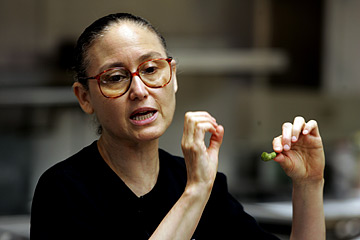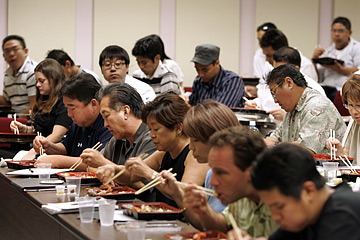
DENNIS ODA / DODA@STARBULLETIN.COM
Engaging all the senses is an integral part of Japanese cooking, according to Elizabeth Andoh.
|
|

Author Elizabeth Andoh explains the principles of Japanese home cooking
CULINARY AUTHOR Elizabeth Andoh is passionate about Japanese food. But she wants everyone to know that you don't have to be Japanese -- or know much about Asian food -- to apply the principles of traditional Japanese home cooking to yield more attractive, nutritionally balanced meals.
"Their whole notion of food is to engage all the senses," Andoh told 120 culinary students and professionals at Kapiolani Community College during a rare visit to Hawaii last month.
The class -- sponsored by the nonprofit Hale Aina Ohana, which helps culinary professionals access pioneering ideas through visiting experts -- included a cooking demonstration infused with history and culture. It attracted restaurant owners and chefs Alan Wong and DK Kodama, as well as representatives from Roy's, the Pacific Club, Sergio's, Michel's, Shanghai Bistro, Hilton Hawaiian Village and Diamond Head Grill.
Andoh is an anomaly who connects two disparate cultures. She is Caucasian and a native New Yorker educated at the University of Michigan, but has lived for more than 40 years in Japan, a country that feels more like home to her than anywhere else. She doesn't understand American cell phones, she said, and her computer commands are written in Japanese.
Andoh is a writer, lecturer and business consultant who specializes in Japanese food and culture, and is best known for her cookbooks featuring Japanese food. But she is not a chef, nor does she have formal culinary training. Instead, she said her goal is "to celebrate the home kitchen and the home cook."
Andoh's secondary mission on this trip was to promote her new book "Washoku: Recipes in the Japanese Home Kitchen" (Ten Speed Press, 2005, $35). In Japanese,
wa means harmony and
shoku is food. In general,
washoku is not only about what we eat, but also "the thinking that goes behind it," she explained.
She'd like to bring this concept to middle America -- where people are far more removed from Japanese culture than most Hawaii residents -- and "see what happens."
"You don't have to be Japanese to cook Japanese food and cook it very well. I want people to stop thinking of Japanese food as something 'other people' do."
THIS WAS the fourth book for the 63-year-old Andoh, who approached the task differently this time. She scouted volunteers who did not live in large urban areas and had no previous experience with Japanese food. Her solicitation -- through her newsletter -- earned 210 replies. She limited the group to 50.
"I was looking for a wide demographic," said Andoh. She gave each person recipes to prepare, after which they completed questionnaires about the ease and success of each meal. Over the course of a year, her volunteers cooked 20 to 25 dishes, and gave Andoh invaluable feedback along the way.
Long after the process was completed, Andoh distributed two simple queries: What are you still making and why? What would you never make again and why?
If everyone agreed not to use a recipe again, it didn't appear in the book. Such practicality, she knew, would be the key to the cookbook's success.
In addition to finding recipes people would actually use, Andoh stressed the versatility of washoku notions, which focus on aesthetic harmony and nutritional balance at mealtime -- in sets of five.
Cooks can apply these concepts to any meal on any occasion. First there is color: Red, green, yellow, white, black. The next category is taste: sweet, sour, salty, spicy and bitter. Transformation is the another area to be aware of: Is the food eaten raw? Simmered in liquid? Perhaps seared? Grilled? Or steamed? All of these methods involve altering the food.

DENNIS ODA / DODA@STARBULLETIN.COM
Chef Alan Wong of Alan Wong's Restaurant was part of the group of culinary professionals and students taking in Elizabeth Andoh's class
|
|
Senses relate to smell, taste, sound, appearance and texture. There are also five outlooks that highlight a sense of time and place. This includes enjoying food at its seasonal peak.
Varying colors, flavors, textures, preparation techniques and presentation makes it impossible to avoid a balanced meal. "If you've got your different (cooking) methods, you're going to be controlling calories." Furthermore, she added, "you feel better and more sated by the food if it looks good and is appropriately plated." This helps prevent overeating.
"The Japanese like to make sure that every meal has representation" from all five color, taste and transformation notions. It's not about equal time, nor do they have to occur in a single dish. In fact, the concept of lots of little dishes -- like today's tapas bars -- can be traced back to the 12th century. "It's a very ancient pattern," she said.
ANDOH also serves as the director of A Taste of Culture, a culinary arts program in Tokyo that helps visitors explore Japan's culture through its food. Fern Tomisato, professor in the Culinary Arts Department at Kapiolani Community College, participated in one of Andoh's tours of Japan last year, and wanted Andoh to share her expertise with professionals in Hawaii.
"Because she has the American upbringing and lives Japanese, she can communicate those cultural nuances really well," said Tomisato. "I think some of this is difficult to capture, because there's a difference between local Japanese and Japanese. And sometimes I think it's good to be reminded about what that is all about."

DENNIS ODA / DODA@STARBULLETIN.COM
Culinary professionals and students sample the cooking in Elizabeth Andoh's class
|
|
Andoh's efforts to bring home cooking back to its foundations also involved exploring the basics of the Japanese home pantry. Participants in the KCC class tasted different types of miso, soy sauce and vinegar, which she described as ranging from "complete slut to extra virgin," depending on the region.
Though she visits infrequently, Andoh's ties to the islands go back several years. Before becoming a lawyer in Washington, D.C., her daughter was a violist for the Honolulu Symphony. "I'm delighted to be connected and reconnected to Hawaii," she said.
When in Hawaii, Andoh adjusts her cooking. She shops at the local fish auction and incorporates wahoo, Hawaiian ginger and tropical fruits and vegetables into her meals. "No matter where I am, I choose something specific (to that geographic region)," she said.
Adaptation is certainly one of her strengths. In the mid-1960s, at the age of 22, she found herself staying with the Andoh family on the Japanese island of Shikoku. Her marriage to their son several years later sealed her fate. But the adjustment wasn't easy.
"My urban American sensibilities were challenged by more than the rural plumbing that first summer," she wrote in the book, later detailing for the KCC audience the absence of flush toilets, and the need to draw water from a well and chop wood to heat the stove. "Hunger forced me to be adventurous at table, where my curiosity grew, along with my appetite, for things Japanese."
This quest for adventure evolved into a long and successful career. "I knew I didn't want to be a chef or a caterer," she said. "But I recognized there was another opportunity to be a teacher and a writer. I am a storyteller. And there is a story to be told in food."
Miso-Marinated Broiled Fish
1-1/2 pounds fish fillet, with skin, in 4 to 6 pieces
1 teaspoon coarse salt
Lemon or lime wedges (optional)
Blushing Pink Ginger (optional)
» Marinade:
1/3 cup sweet, light miso (preferably Saikyo)
2 tablespoons mirin
1 tablespoon sake
1 tablespoon freeze-dried yuzu peel, crushed into powder, or grated fresh lemon or orange zest (optional)
Rinse fish under cold running water and pat dry. Place on paper towels and sprinkle both sides with salt. Let stand 5 minutes, or until it "sweats." Blot away excess moisture with paper towels.
Lay single thickness of sarashi cloth or double thickness of cheesecloth or surgical gauze over baking sheet. Arrange fish on cloth without overlapping. Cover with more cloth.
Combine marinade ingredients; stir to mix well. Use pastry brush to paint cloth-wrapped fish with marinade. Flip fish pieces and paint other side. Let marinate at cool room temperature (no warmer than 75 degrees) at least 20 minutes or in the refrigerator up to 1 hour. Fish will become a bit slippery.
Preheat a broiler or prepare a medium-hot grill. Scrape away marinade and remove fish from cloth wrapping.
If broiling, place fish pieces skin side up in shallow broiler pan (disposable aluminum pan is OK) and broil 3 inches from heat source. If grilling, place skin side down on grill, as marinade scorches easily. Broil or grill 3 to 4 minutes, until skin begins to bubble and even chars a bit in places. Flip pieces and broil or grill another 2 to 3 minutes. Fish will be slightly crusty and golden on surface and white (or pink, if using salmon) and succulent inside.
Arrange on serving plates. To enhance citrus overtones, serve with lemon wedges. For a spicier accent, garnish with pickled ginger. Serves 4 to 6.
Approximate nutritional analysis, per serving (based on 4 servings): 300 calories, 12 g total fat, 1.5 g saturated fat, 95 mg cholesterol, greater than 1,500 mg sodium, 7 g carbohydrate, no fiber, 2 g sugar, 36 g protein.
Gingery Seared Pork
12 to 14 ounces boneless lean pork butt
2 teaspoons ginger juice (see note)
2 tablespoons sake
1-1/2 tablespoons soy sauce
3 bell peppers, 1 each green, red and yellow, quartered lengthwise with stems, seeds and ribs discarded
2 tablespoons canola or other mild vegetable oil
Partially freeze pork to make it easier to slice, then cut into paper-thin slices across grain (normally 12 to 15 large slices and some shreds).
Stir together ginger juice and sake in shallow glass container. Dip pork pieces in mixture 1 at a time, turning to coat. Place all pieces in container with remaining liquid. Cover and refrigerate for 20 minutes to 1 day.
Just before cooking, add soy sauce.
Heat skillet over high heat; add 1 tablespoon oil. Tilt and rotate skillet to coat surface. To test oil, flick a drop of marinade into pan; it should sizzle loudly and be instantly aromatic. Add pork in batches to skillet and sear until meat begins to buckle and edges change color, about 30 seconds. Flip slices and sear other side, flattening slices with back of spatula to prevent excessive curling. Remove slices as they change color. Set aside on plate.
Lower heat and add peppers, skin side down. Sear about 45 seconds, letting them brown, blister slightly and become aromatic. Add a drop more oil to skillet, if necessary, to keep peppers from scorching. Remove peppers and set aside on plate.
Return pork, all at once, to skillet with juices that have collected on plate. Sauté over high heat, turning several times, for about 2 minutes, until all surfaces are well-glazed and slightly browned. Return peppers to skillet for final 30 seconds. Cover skillet just before removing from heat to retain heat, so pork and peppers continue to cook a few extra moments. Serves 4.
Approximate nutritional analysis, per serving: 360 calories, 27 g total fat, 8 g saturated fat, 70 mg cholesterol, 450 mg sodium, 8 g carbohydrate, 2 g fiber, 4 g sugar, 19 g protein.
Note: To make ginger juice, peel a knob of fresh ginger and rub in a circular motion over a metal or ceramic grater. Gently squeeze the gratings to extract juice; discard the fibrous pulp.
Nutritional analyses by Joannie Dobbs, Ph.D., C.N.S.

